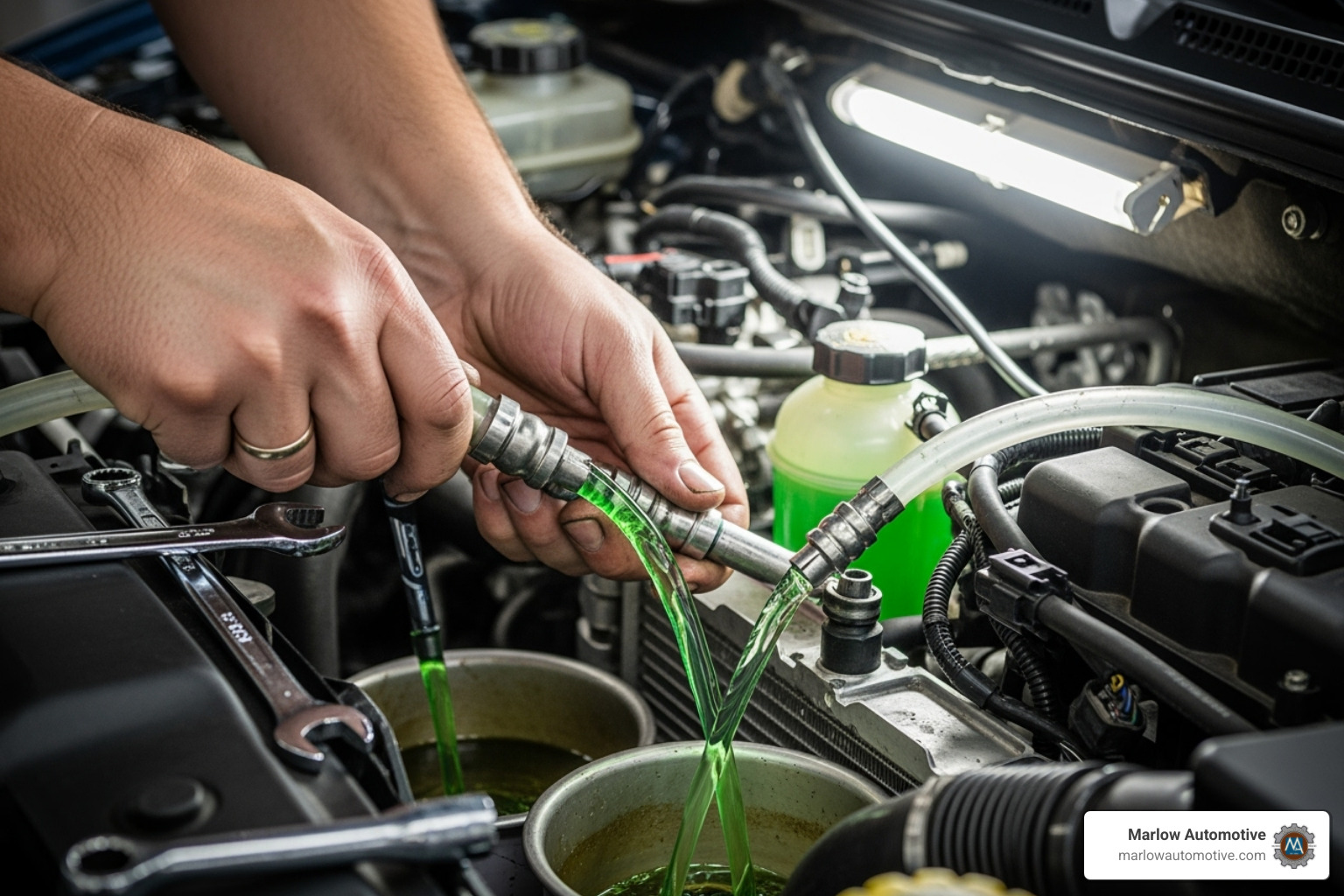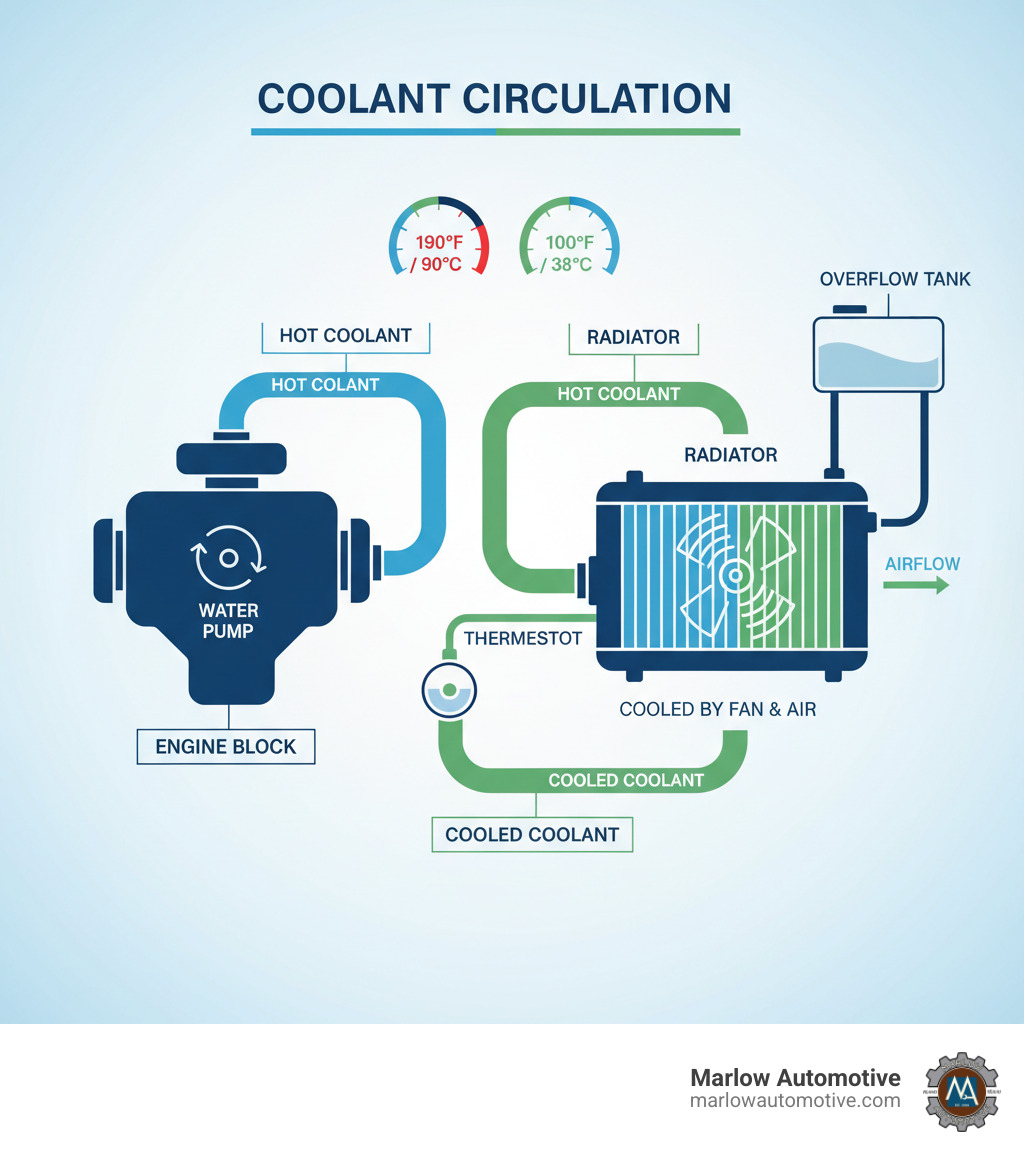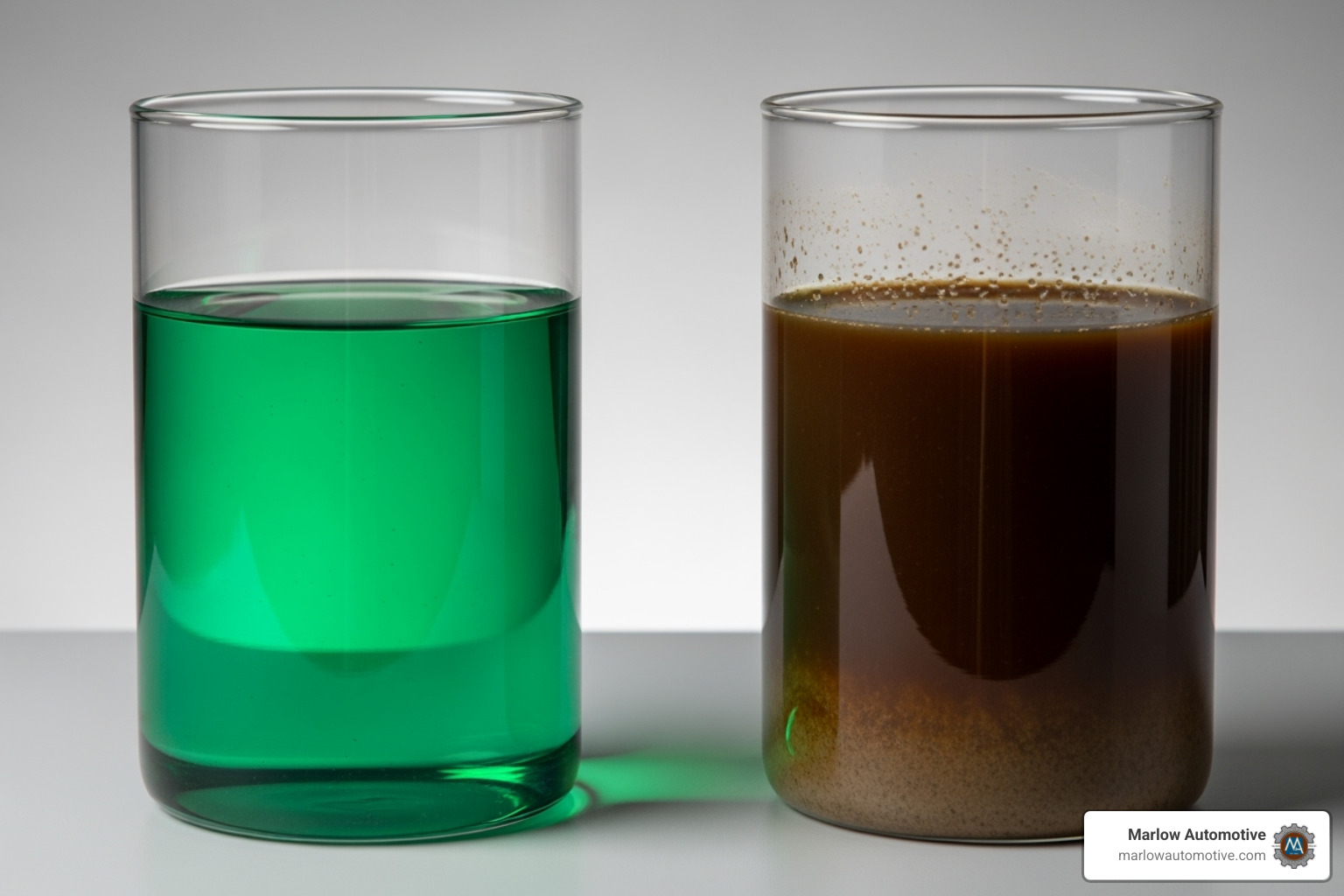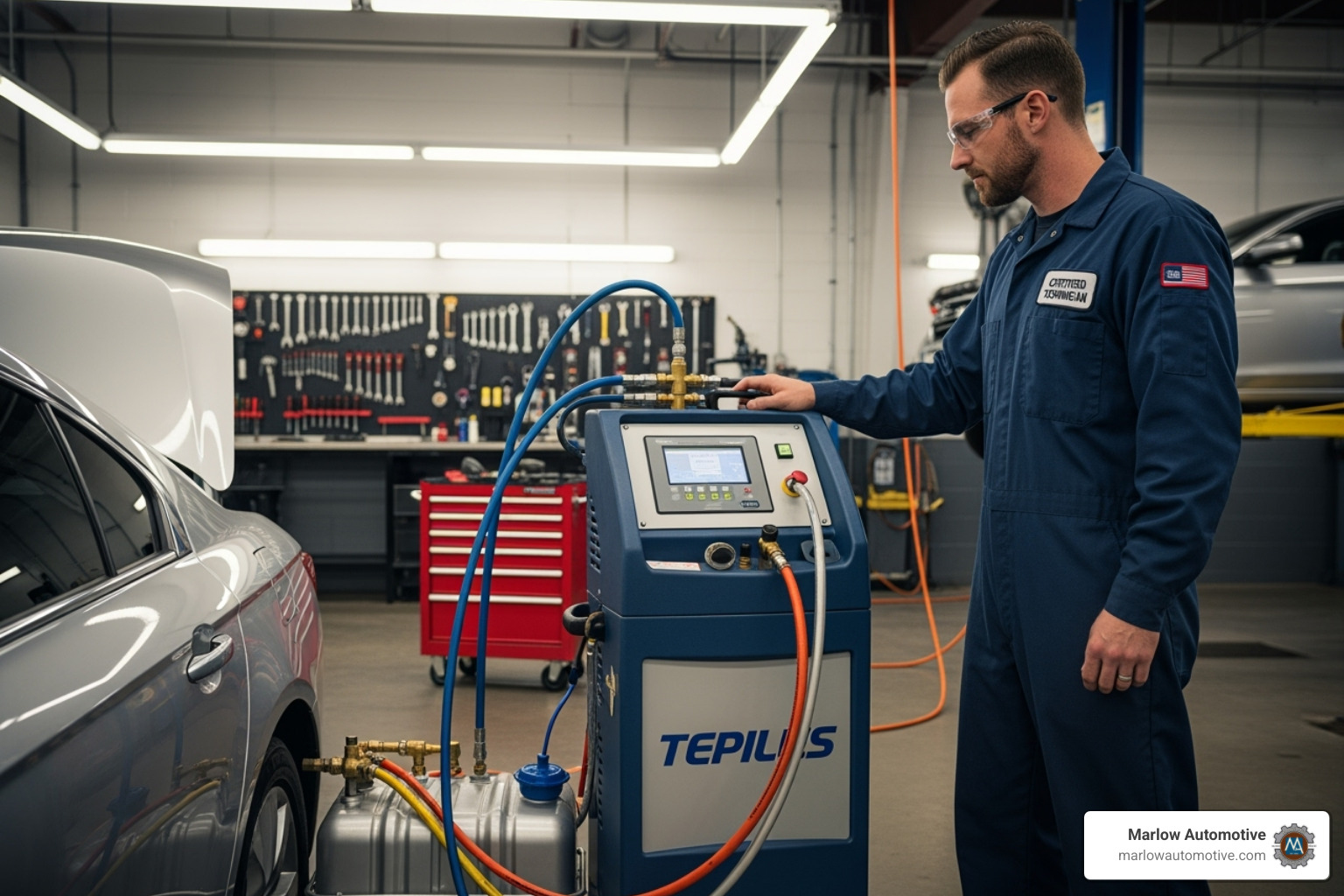The Cool Down: Why Your Car Needs a Coolant Flush Service

Why Your Engine Depends on Regular Coolant Maintenance
A coolant flush service is a complete cleaning and replacement of your vehicle's cooling system fluid to prevent overheating and protect your engine from costly damage. This essential maintenance removes old, contaminated coolant and replaces it with fresh fluid that properly regulates engine temperature.
What is a coolant flush service?
- Complete drain and replacement of cooling system fluid
- Removes rust, scale, and contaminants from the system
- Uses specialized equipment to thoroughly clean internal components
- Refills with manufacturer-specified coolant mixture
Why do you need it?
- Prevents engine overheating and damage
- Extends cooling system component life
- Maintains proper lubrication for water pump
- Protects against corrosion and freezing
When should you get one?
- Every 50,000-100,000 kilometers for normal driving
- Every 30,000-50,000 kilometers for severe conditions
- When coolant appears dirty or discolored
- If you notice overheating or sweet smells
Your car's cooling system works harder than you might think. It circulates coolant through your engine to absorb heat, then sends that hot fluid to the radiator where it cools down before cycling back. Over time, this coolant becomes acidic and contaminated with rust and debris - much like how oil breaks down and needs changing.
"The cooling system uses coolant to heat the passenger cabin," notes industry research, highlighting how this system does double duty for both engine cooling and cabin comfort. When coolant degrades, it can't protect your engine effectively, potentially leading to expensive repairs that could have been prevented with regular maintenance.

What is a Coolant Flush and Why is it Your Engine's Best Friend?
Your car's engine is a lot like a marathon runner on a hot summer day. When it's working hard, it generates tremendous heat that needs to go somewhere fast. Without proper cooling, your engine would literally cook itself to death in minutes. That's where coolant (also called antifreeze) comes to the rescue as your engine's personal cooling system.
Coolant is much more than colored water. It's a carefully engineered fluid, usually a 50/50 mix of water and ethylene or propylene glycol. Its main job is heat transfer – absorbing the intense heat your engine creates during combustion and carrying it away to the radiator where it can escape into the air.
But coolant wears multiple hats in your engine. It prevents the water in your system from freezing solid in winter (imagine the damage from ice expansion!) and stops it from boiling away in summer heat. The fluid also provides corrosion protection for all those metal components and offers lubrication for your water pump, keeping it running smoothly.
Here's where things get interesting – and not in a good way. Over time, even the best coolant becomes your engine's enemy instead of its friend. The protective additives break down, and old coolant becomes acidic. This acidic soup loses its rust-fighting powers and actually starts attacking your engine's metal parts.
The result? Rust and scale buildup throughout your cooling system. Imagine trying to drink a thick milkshake through a clogged straw – that's what happens when debris clogs your radiator and cooling passages. Your engine can't stay cool, and expensive damage follows.
This is exactly why a coolant flush service is so important. It's like giving your engine's circulatory system a complete blood transfusion, removing all that contaminated fluid and replacing it with fresh, protective coolant.

The Benefits of a Regular Coolant Flush
Getting a regular coolant flush service is like giving your car's cooling system a spa day – it comes out refreshed, clean, and ready to protect your engine for thousands more miles. The benefits go far beyond just having clean-looking fluid.
First, a proper flush removes contaminants that build up over time. We're talking about rust particles, scale deposits, dirt, and other nasty stuff that shouldn't be swimming around in your cooling system. These particles are like sandpaper, grinding away at your radiator and heater core from the inside.
The flush also protects your radiator by getting rid of those abrasive particles and corrosive old coolant. Your radiator is essentially a maze of thin tubes and fins – when debris clogs these passages, your engine can't cool properly, and overheating becomes a real threat.
Your water pump gets some love too. Fresh coolant lubricates the water pump with new additives that keep its seals and bearings happy. A failing water pump can spell disaster for your engine, so this protection is crucial. If you're curious about water pump issues, check out our guide on water pump repair.
Perhaps most importantly, a flush prevents rust from eating away at your engine block, cylinder heads, and other expensive metal components. New coolant comes loaded with fresh anti-corrosion additives that form a protective barrier against rust and corrosion.
All of this adds up to one big benefit: extending your engine's life. A clean, efficient cooling system keeps your engine running at the perfect temperature, preventing the overheating that can warp cylinder heads, blow head gaskets, and turn your reliable car into an expensive paperweight.
Coolant Flush vs. Coolant Top-Up
Many car owners think adding more coolant when the level gets low is the same as getting a coolant flush service. That's like thinking a band-aid fixes a broken bone – they're completely different solutions for different problems.
A coolant top-up is exactly what it sounds like: pouring more fluid into your reservoir when it's running low. Maybe you have a small leak, or some fluid evaporated over time. A top-up gets your fluid level back where it should be, which is important for proper cooling.
But here's the catch – if your existing coolant is old, acidic, and full of contaminants, adding fresh coolant is like pouring clean water into a dirty fish tank. The new stuff gets contaminated immediately, and you haven't solved the underlying problem.
A coolant flush service is completely different. We drain every drop of old fluid from your system, then use specialized equipment to circulate cleaning agents through all the passages, hoses, and components. This process dislodges and removes built-up rust, scale, and debris that a simple drain-and-fill would leave behind.
| Coolant Flush Service | Coolant Top-Up |
|---|---|
| Complete system cleaning and fluid replacement | Simply adds fluid to restore proper levels |
| Removes all contaminants and debris | Leaves existing contaminants in place |
| Restores full cooling efficiency and protection | Temporary fix for low fluid levels only |
| Prevents corrosion with fresh additives | Doesn't refresh protective properties |
| Recommended every 50,000-100,000 km | Done as needed when levels drop |
Think of it this way: a top-up is like adding water to a dirty bathtub, while a flush is like draining the tub, scrubbing it clean, and filling it with fresh water. Both involve adding fluid, but only one actually cleans your system.
Timing is Everything: When to Get a Coolant Flush Service
Just like you wouldn't wait until your teeth hurt to see the dentist, you shouldn't wait until your engine overheats to think about coolant maintenance. Understanding when to get a coolant flush service can make the difference between a smooth-running engine and an expensive repair bill that ruins your weekend plans.
The beauty of proactive maintenance is that it keeps small problems from becoming big headaches. When you stay ahead of your cooling system's needs, you're not just protecting your engine – you're protecting your wallet and your peace of mind too.

Manufacturer Recommendations and General Guidelines
Your owner's manual might not be the most exciting bedtime reading, but it's your best friend when it comes to maintenance schedules. Car manufacturers spend millions of dollars testing their vehicles, and their coolant service recommendations are based on real-world data specific to your make and model.
That said, here's what we typically see in the real world. For normal driving conditions – think regular commuting, weekend errands, and the occasional road trip – most vehicles need a coolant flush service every 50,000 to 100,000 kilometers. This range covers the majority of cars on the road today.
But life isn't always "normal," is it? If you're dealing with severe driving conditions, your cooling system works much harder. We're talking about extreme heat, heavy stop-and-go traffic during rush hour, towing your boat to the lake, or tackling those dusty back roads. In these situations, your coolant degrades faster, and we recommend a flush every 30,000 to 50,000 kilometers.
Some newer vehicles, especially certain Toyota models, use long-life coolant that can go up to 160,000 kilometers between services. Sounds great, right? Just remember that "long-life" doesn't mean "forever," and even these advanced coolants eventually lose their protective powers.
Here's the thing though – even if your odometer hasn't hit those mileage markers, time still matters. Coolant can break down just sitting there, especially in older vehicles. That's why comprehensive auto maintenance includes regular coolant checks, regardless of how many miles you've driven.
5 Warning Signs Your Car Needs a Coolant Flush
Your car has a way of telling you when something's wrong, even without words. The trick is learning to listen. When your cooling system starts struggling, it sends out clear distress signals that you really don't want to ignore. Catching these signs early can save you from that heart-stopping moment when steam starts pouring from under your hood.
High temperature gauge readings are your engine's way of waving a red flag. When that needle starts creeping toward the danger zone, your coolant isn't doing its job anymore. This often means the fluid has become so contaminated or degraded that it can't absorb and transfer heat properly. If you're seeing consistent overheating issues, our car overheating repair service can help diagnose the root cause.
Visible coolant leaks show up as colorful puddles under your parked car – usually bright green, pink, or orange depending on your coolant type. While a flush won't fix the leak itself, old acidic coolant often contributes to the corrosion that causes these leaks in the first place.
That sweet, syrupy smell you notice around your car isn't someone's breakfast – it's coolant. This distinctive maple syrup-like odor usually means coolant is leaking onto hot engine parts and evaporating. It's your nose telling you that something needs attention under the hood.
Take a peek at your coolant reservoir when the engine is cool. Discolored or sludgy coolant that looks rusty, muddy, or cloudy is a dead giveaway that it's time for fresh fluid. Clean coolant should look vibrant and clear, not like something you'd find in a swamp.
Finally, when your heater blows cold air even after your engine has warmed up, it might surprise you to learn this could be a coolant issue. Your car's heating system relies on hot coolant to warm the cabin, so problems here often point back to cooling system troubles.
If any of these warning signs sound familiar, don't play the waiting game. The sooner you address cooling system issues, the less likely they are to turn into expensive engine repairs.
The Professional Coolant Flush Process
When you bring your vehicle to Marlow Automotive for a coolant flush service, you're getting much more than a simple drain and refill. Think of it as giving your cooling system a spa day – complete with deep cleaning, thorough inspection, and rejuvenation. Our certified technicians follow a meticulous process that ensures every component of your cooling system gets the attention it deserves.
We start with a comprehensive system inspection because you can't fix what you don't understand. Our technicians examine every part of your cooling system – the hoses, clamps, radiator, water pump, and thermostat – looking for signs of wear, leaks, or potential problems. We also test your existing coolant to check its condition and pH level. This tells us exactly what we're dealing with and helps us spot any issues that might need attention beyond the flush.
Next comes draining the old fluid, which sounds simple but requires care and expertise. We safely remove all the old, degraded coolant from your system, making sure every drop is captured. This isn't just about being thorough – coolant is toxic and harmful to the environment, so proper disposal is both responsible and required by law.
Here's where our specialized equipment really shines. We connect a professional flushing machine to your cooling system and circulate powerful yet safe cleaning agents throughout the entire network of passages. These cleaning agents work like a gentle but effective detergent, breaking down and loosening all the accumulated rust, scale, and sediment that has built up over months or years of operation.
The real magic happens during the debris removal phase. We thoroughly flush out all the cleaning agents and dislodged contaminants, often repeating this process multiple times with clean water until the fluid running through your system is crystal clear. This means all the gunk is gone and no harmful cleaning residues are left behind to cause future problems.
Finally, we refill your system with the correct coolant – and this part is crucial. We use only manufacturer-specified coolant in the precise mixture ratio, ensuring optimal performance and protection. After refilling, we perform a comprehensive leak check and run your engine to operating temperature, testing circulation, thermostat function, and system pressure. This confirms everything is working perfectly before you drive away.

This thorough approach means your cooling system isn't just topped off – it's completely revitalized and ready to protect your engine for thousands of miles ahead.
Why the Right Type of Coolant Matters
Here's something that might surprise you: not all coolants are created equal, and using the wrong type can actually damage your engine. It's like putting the wrong type of oil in your car – technically it's still oil, but it won't do the job your engine needs.
Modern coolants fall into three main categories based on their chemical makeup. Inorganic Acid Technology (IAT) coolants are the traditional green ones you might remember from older cars. They contain silicates and phosphates for corrosion protection but need more frequent replacement. Organic Acid Technology (OAT) coolants are often orange, red, or yellow and offer longer-lasting protection without silicates – perfect for extended service intervals. Hybrid Organic Acid Technology (HOAT) coolants combine the best of both worlds, offering extended life with some silicate protection.
But here's the really important part: manufacturer specifications matter more than color. Your car's manufacturer didn't just pick a coolant type randomly – they designed the entire cooling system around specific chemical properties. Using the wrong coolant can cause chemical reactions that create gel-like substances, accelerate corrosion of metal components, or reduce the lifespan of hoses and gaskets.
Don't rely on color to choose your coolant either. Different manufacturers use different dyes, so orange coolant from one brand might be completely incompatible with orange coolant from another. It's like assuming all red wines taste the same – they definitely don't!
Modern vehicles have even more specific needs. Electric vehicles like the Hyundai Ioniq 5 require low conductivity coolant to protect sensitive electrical components from short circuits. As some EV owners have finded, these specialized coolants are essential for maintaining the integrity of complex electrical systems that traditional cars don't have.
At Marlow Automotive, we take the guesswork out of coolant selection. We always use coolants that meet or exceed your vehicle manufacturer's specifications, ensuring your cooling system gets exactly what it needs for optimal performance and protection. For vehicles with specialized electrical cooling needs, our auto electrical services team has the expertise to handle even the most complex requirements.
Frequently Asked Questions about Coolant Flushes
We get lots of questions about coolant flush service from our customers in Plano. It makes perfect sense - you want to understand what you're paying for and whether it's really worth it. Let's explore the most common questions we hear every day.
Is a coolant flush really necessary for modern cars?
This is probably our most frequent question, and the short answer is absolutely yes! We totally understand why people ask this. Modern cars seem so advanced, and manufacturers often advertise "long-life" coolants that can last 100,000 miles or more. It's tempting to think your car's cooling system is maintenance-free.
Here's the reality though - even the best coolants aren't immortal. Over time, they still face the same challenges that have plagued cooling systems for decades. The anti-corrosive properties gradually weaken, leaving your engine vulnerable to rust and scale buildup. The coolant becomes more acidic, which means it starts attacking the very components it's supposed to protect.
Think of it like sunscreen. Even the highest SPF sunscreen breaks down after hours in the sun and needs reapplying. Your coolant works similarly - it starts strong but loses its protective powers over time, accumulating contaminants that reduce its effectiveness.
Modern engines actually make this more critical, not less. Today's engines run hotter and have tighter tolerances than older designs. They simply can't afford to have compromised cooling. A coolant flush service ensures your engine gets the protection it was designed to have.
How long does a professional coolant flush take?
Great news here - a professional coolant flush service won't eat up your entire day! Using our specialized equipment, we can typically complete a thorough flush in about 1 to 1.5 hours. This includes everything: draining the old fluid, circulating cleaning agents through the system, flushing out all the debris, and refilling with fresh coolant that meets your manufacturer's specifications.
The efficiency comes from having the right tools for the job. Our flush machines can circulate cleaning solutions and fresh coolant much faster than trying to do this by hand. Plus, we perform a complete system check at the end to make sure everything's working perfectly.
It's honestly one of the best time investments you can make for your vehicle. An hour and a half of service can prevent hours of being stranded on the roadside with an overheated engine!
Can a coolant flush fix an overheating problem?
This depends entirely on what's causing your engine to overheat. If the problem stems from old, inefficient coolant or minor clogs in the system, then yes - a coolant flush service can absolutely solve your overheating issues. We've seen this happen many times where contaminated coolant was blocking proper heat transfer, and a thorough flush restored normal operating temperatures.
However, we need to be honest with you. A coolant flush isn't a magic fix for every overheating problem. If your engine is running hot because of a failing thermostat, damaged radiator, or worn water pump, those components need actual repair or replacement. No amount of fresh coolant will fix a broken part.
When you bring an overheating vehicle to us, we always start with a complete diagnostic. Sometimes it's as simple as degraded coolant that needs flushing. Other times, we might find issues with your thermostat or radiator that require more extensive repair.
The good news is we'll always explain exactly what we find and give you clear options. Our goal is getting your engine back to running cool and reliable, whether that takes a simple flush or something more involved.
Trust Your Vehicle to the Experts in Plano, TX
Your engine is truly a marvel of engineering, working tirelessly under extreme conditions every time you turn the key. And while it might not get the recognition it deserves, your cooling system is the quiet guardian that keeps everything running smoothly. A regular coolant flush service isn't just maintenance – it's an investment in your vehicle's future, ensuring countless reliable miles ahead.
When you choose Marlow Automotive for your coolant flush service, you're getting more than just a routine procedure. You're investing in comprehensive engine protection that shields your vehicle from overheating, corrosion, and the kind of premature wear that can turn a simple drive into an expensive nightmare. There's real peace of mind that comes from knowing your cooling system is in optimal condition, ready to handle whatever the Texas heat throws at it.
Our expert technicians understand that quality care means doing things right the first time. We use only the best parts and employ highly skilled professionals who treat your vehicle like it's their own. Throughout every service, we maintain constant communication with you because we believe you deserve to know exactly what's happening with your car.
What really sets us apart is our commitment to your satisfaction. We stand behind every coolant flush service with our robust 2-year/24,000-mile warranty. That's not just a promise – it's our guarantee that the work we do today will keep protecting your engine tomorrow.
Don't wait for that temperature gauge to start climbing or for sweet-smelling puddles to appear under your car. The best time to care for your cooling system is before problems arise. We're proud to serve drivers throughout Plano, Garland, Carrollton, Frisco, Fairview, Lucas, McKinney, Allen, Richardson, and the entire DFW area with the kind of proactive maintenance that extends vehicle lifespan and prevents costly surprises.
Ready to give your engine the protection it deserves? Schedule your coolant flush service in Plano, TX with us today. Let's help your car stay cool, calm, and collected on every Texas road ahead!
Customer Testimonials
Service Areas







